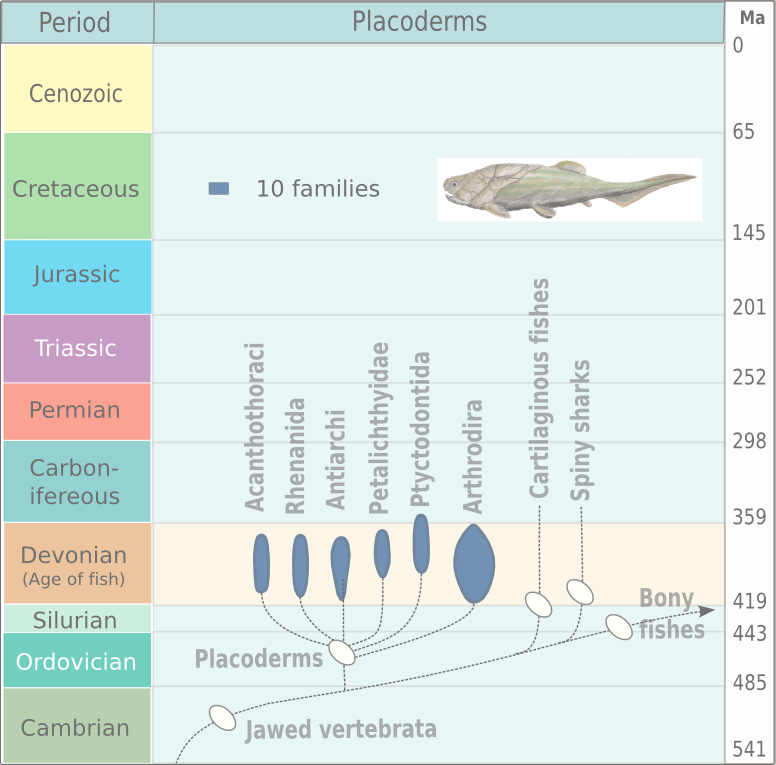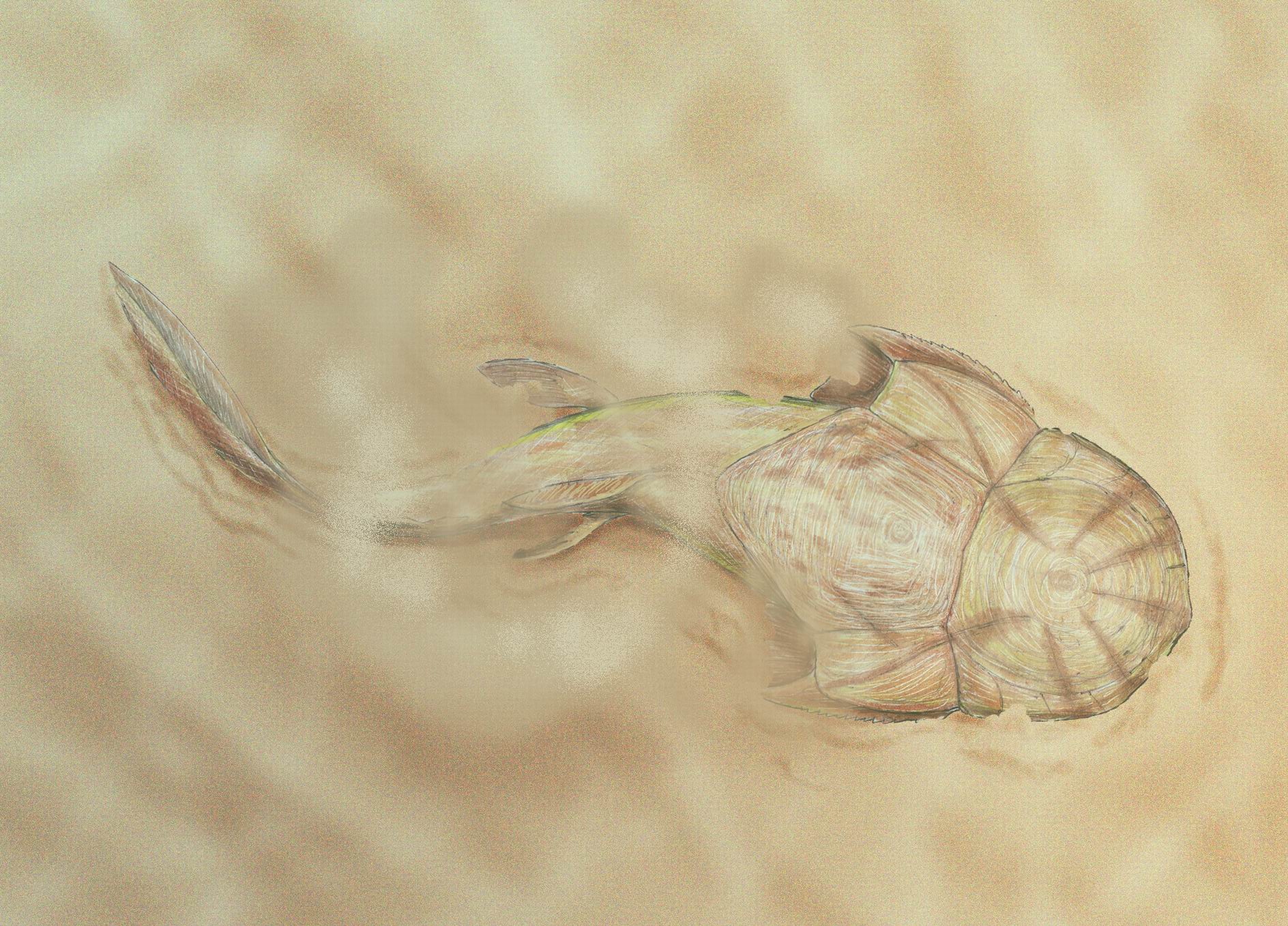|
Arthrodire
Arthrodira (Greek for "jointed neck") is an Order (biology), order of extinct armored, jawed fishes of the class Placodermi that flourished in the Devonian period before their sudden extinction, surviving for about 50 million years and penetrating most marine ecological niches. Arthrodires were the largest and most diverse of all groups of Placoderms. Description Arthrodire placoderms are notable for the movable joint between armor surrounding their heads and bodies. Like all placoderms, they lacked distinct teeth; instead, they used the sharpened edges of a bony plate on their jawbone as a biting surface. The eye sockets are protected by a bony ring, a feature shared by birds and some ichthyosaurs. Early arthrodires, such as the genus ''Arctolepis'', were well-armoured fishes with flattened bodies. The largest member of this group, ''Dunkleosteus'', was a true superpredator of the latest Devonian period, reaching as much as 6 m in length. In contrast, the long-nosed ''Rolfosteus ... [...More Info...] [...Related Items...] OR: [Wikipedia] [Google] [Baidu] |
Placodermi
Placodermi (from Greek πλάξ 'plate' and δέρμα 'skin', literally 'Plate (animal anatomy), plate-skinned') is a Class (biology), class of armoured prehistoric fish, known from fossils, which lived from the Silurian to the end of the Devonian period. Their head and thorax were covered by articulated armoured plates and the rest of the body was scale (zoology), scaled or naked, depending on the species. Placoderms were among the first jawed fish; their Fish jaw, jaws likely evolved from the first of their gill arches. Placoderms are thought to be paraphyly, paraphyletic, consisting of several distinct Outgroup (cladistics), outgroups or sister taxon, sister taxa to all living jawed vertebrates, which originated among their ranks. In contrast, one 2016 analysis concluded that placodermi are likely monophyletic, though these analyses have been further dismissed with more transitional taxa between placoderms and modern gnathosthomes, solidifying their paraphyletic status. Plac ... [...More Info...] [...Related Items...] OR: [Wikipedia] [Google] [Baidu] |
Arthrodira
Arthrodira (Greek for "jointed neck") is an order of extinct armored, jawed fishes of the class Placodermi that flourished in the Devonian period before their sudden extinction, surviving for about 50 million years and penetrating most marine ecological niches. Arthrodires were the largest and most diverse of all groups of Placoderms. Description Arthrodire placoderms are notable for the movable joint between armor surrounding their heads and bodies. Like all placoderms, they lacked distinct teeth; instead, they used the sharpened edges of a bony plate on their jawbone as a biting surface. The eye sockets are protected by a bony ring, a feature shared by birds and some ichthyosaurs. Early arthrodires, such as the genus ''Arctolepis'', were well-armoured fishes with flattened bodies. The largest member of this group, ''Dunkleosteus'', was a true superpredator of the latest Devonian period, reaching as much as 6 m in length. In contrast, the long-nosed ''Rolfosteus'' measured just ... [...More Info...] [...Related Items...] OR: [Wikipedia] [Google] [Baidu] |
Phlyctaenioidei
Arthrodira (Greek for "jointed neck") is an order of extinct armored, jawed fishes of the class Placodermi that flourished in the Devonian period before their sudden extinction, surviving for about 50 million years and penetrating most marine ecological niches. Arthrodires were the largest and most diverse of all groups of Placoderms. Description Arthrodire placoderms are notable for the movable joint between armor surrounding their heads and bodies. Like all placoderms, they lacked distinct teeth; instead, they used the sharpened edges of a bony plate on their jawbone as a biting surface. The eye sockets are protected by a bony ring, a feature shared by birds and some ichthyosaurs. Early arthrodires, such as the genus ''Arctolepis'', were well-armoured fishes with flattened bodies. The largest member of this group, ''Dunkleosteus'', was a true superpredator of the latest Devonian period, reaching as much as 6 m in length. In contrast, the long-nosed ''Rolfosteus'' measured ju ... [...More Info...] [...Related Items...] OR: [Wikipedia] [Google] [Baidu] |
Incisoscutum
''Incisoscutum'' is an extinct genus of arthrodire placoderm from the Early Frasnian Gogo Reef, from Late Devonian Australia. The genus contains two species ''I. ritchiei'', named after Alex Ritchie, a palaeoichthyologist and senior fellow of the Australian Museum, and ''I. sarahae'', named after Sarah Long, daughter of its discoverer and describer, John A. Long. The genus is important in the study of early vertebrates as well-preserved fossilized embryos have been found in female specimens and ossified pelvic claspers found in males. This shows that viviparity and internal fertilization was common amongst these primitive jawed vertebrates, which are outside the crown group Gnathostomata. In a study of fossil remains, comparison of the ontogeny of fourteen dermal plates from '' Compagopiscis croucheri'' and the more derived species ''Incisoscutum ritchiei'' suggested that lengthwise growth occurs earlier in the ontogeny than growth in width, and that dissociated allometric het ... [...More Info...] [...Related Items...] OR: [Wikipedia] [Google] [Baidu] |
Dunkleosteus
''Dunkleosteus'' is an extinct genus of large armored, jawed fishes that existed during the Late Devonian period, about 382–358 million years ago. It consists of ten species, some of which are among the largest placoderms to have ever lived: ''D. terrelli'', ''D. belgicus'', ''D. denisoni'', ''D. marsaisi'', ''D. magnificus'', ''D. missouriensis'', ''D. newberryi'', ''D. amblyodoratus'', and ''D. raveri''. The largest and most well known species is ''D. terrelli'', which grew up to long and in weight. ''Dunkleosteus'' could quickly open and close its jaw, like modern-day suction feeders, and had a bite force of at the tip and at the blade edge. Numerous fossils of the various species have been found in North America, Poland, Belgium, and Morocco. Etymology ''Dunkleosteus'' was named in 1956 to honour David Dunkle (1911–1982), former curator of vertebrate paleontology at the Cleveland Museum of Natural History. The genus name ''Dunkleosteus'' combines David Dunkle's sur ... [...More Info...] [...Related Items...] OR: [Wikipedia] [Google] [Baidu] |
Groenlandaspididae
''Groenlandaspis'' is an extinct genus of arthrodire from the Late Devonian. Fossils of the different species are found in late Devonian strata in all continents except eastern Asia. The generic name commemorates the fact that the first specimens of the type species were found in Greenland. Description As with all other arthrodires, ''Groenlandaspis'' had a joint in the back of its head with its thoracic armor, allowing for its head to be thrown back, increasing its gape. However, as its head is somewhat compressed in comparison with many other arthrodires, and as the dorsal side came to a low, pyramid-like peak, it is believed that ''Groenlandaspis'' could not crane its head back very far. It was a relatively small fish, only in length on average, though one unusually large species, ''G. riniensis'', reached almost a metre in length Gess, Robert W.; Whitfield, Alan K. (August 22, 2020). "Estuarine fish and tetrapod evolution: insights from a Late Devonian (Famennian) Gondwanan ... [...More Info...] [...Related Items...] OR: [Wikipedia] [Google] [Baidu] |
Dunkleosteus Terrelli
''Dunkleosteus'' is an extinct genus of large armored, jawed fishes that existed during the Late Devonian period, about 382–358 million years ago. It consists of ten species, some of which are among the largest placoderms to have ever lived: ''D. terrelli'', ''D. belgicus'', ''D. denisoni'', ''D. marsaisi'', ''D. magnificus'', ''D. missouriensis'', ''D. newberryi'', ''D. amblyodoratus'', and ''D. raveri''. The largest and most well known species is ''D. terrelli'', which grew up to long and in weight. ''Dunkleosteus'' could quickly open and close its jaw, like modern-day suction feeders, and had a bite force of at the tip and at the blade edge. Numerous fossils of the various species have been found in North America, Poland, Belgium, and Morocco. Etymology ''Dunkleosteus'' was named in 1956 to honour David Dunkle (1911–1982), former curator of vertebrate paleontology at the Cleveland Museum of Natural History. The genus name ''Dunkleosteus'' combines David Dunkle's sur ... [...More Info...] [...Related Items...] OR: [Wikipedia] [Google] [Baidu] |
Rolfosteus
''Rolfosteus'' is an extinct monospecific genus of arthrodire placoderm from the Early Frasnian stage of the Late Devonian period, found at the Gogo Formation of Western Australia.DENNIS, KIM, and R. S. Miles. "Eubrachythoracid arthrodires with tubular rostral plates from Gogo, Western Australia." Zoological Journal of the Linnean Society 67.4 (1979): 297-328. The creature with skull reaching had tough plating on the front of its body. Like other arthrodires such as ''Coccosteus'' and the giant ''Dunkleosteus'', it had sharp, bony plates in its mouth which formed a turtle-like beak for cutting prey to pieces. ''Rolfosteuss most unusual feature was its highly elongated snout, which may have been used to enhance its sense of smell, as well as increase its hydrodynamic streamlining. Phylogeny ''Rolfosteus'' is a member of the family Camuropiscidae under the superfamily Incisoscutoidea, which belongs to the clade Coccosteomorphi, one of the two major clades within Eubrachythoraci. T ... [...More Info...] [...Related Items...] OR: [Wikipedia] [Google] [Baidu] |
Actinolepidae
Actinolepidae is an extinct family of placoderm fishes which lived during the Early Devonian period. They are considered to be among the most primitive of the arthrodires, and are widely accepted to be phylogenetically basal to the group. Description The bodies of Actinolepids are wide and flat, suggesting that most members of this family were benthic fish. Their jaws were comparatively underdeveloped in comparison to the more robust-jawed arthrodires that would come after them, such as ''Dunkleosteus ''Dunkleosteus'' is an extinct genus of large armored, jawed fishes that existed during the Late Devonian period, about 382–358 million years ago. It consists of ten species, some of which are among the largest placoderms to have ever lived: ...'' and '' Coccosteus'', indicating that it likely subsisted primarily on smaller, softer-bodied animals such as mollusks or worms instead of larger, tougher prey animals. References External links * Devonian placoderms ... [...More Info...] [...Related Items...] OR: [Wikipedia] [Google] [Baidu] |
Wuttagoonaspidae
Wuttagoonaspidae is a family of primitive arthrodire placoderms from Early Devonian The Early Devonian is the first of three epochs comprising the Devonian period, corresponding to the Lower Devonian series. It lasted from and began with the Lochkovian Stage , which was followed by the Pragian from and then by the Emsian, ... China and Middle Devonian Australia. References Placoderm families Early Devonian first appearances Middle Devonian extinctions {{Placoderm-stub ... [...More Info...] [...Related Items...] OR: [Wikipedia] [Google] [Baidu] |
Brachythoraci
Brachythoraci is an extinct suborder of arthrodire placoderms, armored fish most diverse during the Devonian. Phylogeny Arthrodira is divided into three main groups: the paraphyletic Actinolepida and Phlyctaenii, and then the monophyletic Brachythoraci. Brachythoraci is then further divided into the large derived clade Eubrachythoraci and several basal groups: Buchanosteoidea, Homosteidae, and Holonematidae. (Although Holonematidae's membership in Brachythoraci is disputed.) Below is a cladogram from the 2016 Zhu ''et al.'' phylogenetic In biology, phylogenetics (; from Greek φυλή/ φῦλον [] "tribe, clan, race", and wikt:γενετικός, γενετικός [] "origin, source, birth") is the study of the evolutionary history and relationships among or within groups o ... study: References Arthrodires Prehistoric animal suborders Fish suborders {{Placoderm-stub ... [...More Info...] [...Related Items...] OR: [Wikipedia] [Google] [Baidu] |
Phyllolepida
Phyllolepida ("leaf scales") is an extinct taxon of flattened placoderms found throughout the world, with fossils being found in Devonian strata. Like other flattened placoderms, the phyllolepids were bottom-dwelling predators that ambushed prey. Unlike other flattened placoderms, the phyllolepids were inhabitants of freshwater environments. Unlike the Rhenanida, the armor of the phyllolepids were made of whole plates, rather than numerous tubercles and scales, and unlike the Petalichthyida, the components of the comparatively wide mouth are known. The phyllolepids are considered to have been blind, as the orbits for the eyes are extremely small, so much so as to suggest that the eyes were vestigial, and that they were placed on the sides of the head, as opposed to visually-oriented bottom-dwelling predators, like, say stargazers or flatfish, which have the eyes placed high on top of the head. Despite having a relatively clear idea of the phyllolepids' lifestyle and anatomy, most ... [...More Info...] [...Related Items...] OR: [Wikipedia] [Google] [Baidu] |





